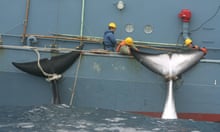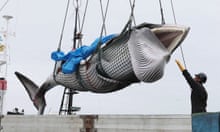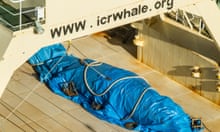Japan is to defy Australia and other nations with plans to replace its whaling fleet’s ageing mother ship, showing its determination to continue its annual expeditions to the Southern Ocean.
The country’s fisheries agency is planning to replace the 30-year-old Nisshin Maru with either a new ship or a refitted one bought overseas, according to the Yomiuri Shimbun.
The newspaper quoted agency officials as saying that a new mother ship was needed to haul whales on board to be butchered during Japan’s controversial “research” hunts in the Antarctic.
Whaling officials have also said they needed a faster ship to evade anti-whaling activists. The marine conservation group Sea Shepherd recently said it was abandoning its pursuit of Japan’s whalers in the Southern Ocean, but has not ruled out a resumption of its campaign.
The group has clashed with the Japanese whaling fleet several times since it started obstructing the vessels in 2005.
The introduction of a new mother ship is expected to anger anti-whaling nations, as it signals Japan’s determination to continue slaughtering hundreds of whales in the Antarctic every winter.

The country resumed its whaling programme in 2016, two years after the international court of justice said that the hunts should end because they were not, as Japan had claimed, conducted for scientific research.
Japan responded by revising its whaling plan, including reducing its catch quota by about a third.
The fleet left port at the end of last year aiming to catch 333 minke whales during its four-month expedition.
Critics of its whaling programme say the industry is propped up by taxpayers’ money. Annual subsidies, channelled through Japan’s Institute for Cetacean Research, averaged about ¥782m (£5m) between 1987 and 2012, according to a report by the International Fund for Animal Welfare.
“Many countries distrust Japan, which continues to kill whales in the name of research using massive subsidies,” Nanami Kurasawa, secretary general of the Dolphin and Whale Action Network, told the Yomiuri. “The renewal of the mother ship would attract heavy criticism.”
Built in 1987, the Nisshin Maru is capable of holding up to 1,200 tons of whale meat in freezers below deck.
The International Whaling Commission imposed a moratorium on commercial whaling in 1986, but a clause in the ban allows Japan to catch whales and sell the meat on the open market, despite a sharp decline in domestic consumption since the postwar period.
Japanese whaling officials say only lethal research can determine the age, reproductive and other habits of whale populations – a claim challenged by environmentalists.










